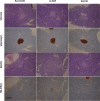Comparison of the response using ICR mice derived from three different sources to multiple low-dose streptozotocin-induced diabetes mellitus
- PMID: 28747981
- PMCID: PMC5527141
- DOI: 10.5625/lar.2017.33.2.150
Comparison of the response using ICR mice derived from three different sources to multiple low-dose streptozotocin-induced diabetes mellitus
Abstract
This study was conducted to compare the multiple low-dose streptozotocin (MLDS)-induced diabetic patterns of Korl:ICR, A:ICR, and B:ICR mice obtained from three different sources. Six-week-old male ICR mice were obtained from three difference sources. Korl:ICR mice were kindly provided by the National Institute of Food and Drug Safety Evaluation (NIFDS). The other two groups of ICR mice were purchased from different vendors located in the United States (A:ICR) and Japan (B:ICR). All ICR mice that received MLDS exhibited overt diabetic symptoms throughout the study, and the incidence and development of diabetes mellitus were similar among the three ICR groups. The diabetic mice exhibited hyperglycemia, loss of body weight gain, decreased plasma insulin levels, impaired glucose tolerance, decreased number of insulin-positive cells, and decreased size of β-cells in the pancreas. The diabetes symptoms increased as the blood glucose level increased in the three ICR groups. In particular, the level of blood glucose in the STZ-treated group was higher in Korl:ICR and A:ICR mice than in B:ICR mice. The plasma insulin levels, glucose tolerance, blood chemistry, and morphological appearance of the pancreas were very similar in the ICR groups obtained from the three different sources. In conclusion, our results suggest that Korl:ICR, A:ICR, and B:ICR mice from different sources had similar overall responses to multiple low-dose STZ to induce diabetes mellitus.
Keywords: Korl:ICR mice; diabetes mellitus; hyperglycemia; multiple low-dose streptozotocin.
Conflict of interest statement
Conflict of interests: The authors declare that there is no financial conflict of interests to publish these results.
Figures





Similar articles
-
Comparison of therapeutic responses to an anticancer drug in three stocks of ICR mice derived from three different sources.Lab Anim Res. 2017 Jun;33(2):187-194. doi: 10.5625/lar.2017.33.2.187. Epub 2017 Jun 30. Lab Anim Res. 2017. PMID: 28747986 Free PMC article.
-
Comparison study of the response with botulinum toxin muscle injection in the ICR mice from three different sources.Lab Anim Res. 2019 Jul 26;35:11. doi: 10.1186/s42826-019-0010-4. eCollection 2019. Lab Anim Res. 2019. PMID: 32257899 Free PMC article.
-
Comparison of commonly used ICR stocks and the characterization of Korl:ICR.Lab Anim Res. 2017 Mar;33(1):8-14. doi: 10.5625/lar.2017.33.1.8. Epub 2017 Mar 27. Lab Anim Res. 2017. PMID: 28400834 Free PMC article.
-
Comparison of the response using ICR mice derived from three different sources to ethanol/hydrochloric acid-induced gastric injury.Lab Anim Res. 2016 Mar;32(1):56-64. doi: 10.5625/lar.2016.32.1.56. Epub 2016 Mar 24. Lab Anim Res. 2016. PMID: 27051443 Free PMC article.
-
Anti-diabetic effects of globin digest and its active ingredient Leu-Ser-Glu-Leu in ICR mice, streptozotocin-induced diabetic mice and KK-Ay mice.Life Sci. 2010 Mar 13;86(11-12):424-34. doi: 10.1016/j.lfs.2010.01.014. Epub 2010 Jan 25. Life Sci. 2010. PMID: 20109472
References
-
- Chia R, Achilli F, Festing MF, Fisher EM. The origins and uses of mouse outbred stocks. Nat Genet. 2005;37(11):1181–1186. - PubMed
-
- Hubrecht RC, Kirkwood J. The UFAW Handbook on the Care and Management of Laboratory and Other Research Animals. 8th ed. Oxford: Wiley-Blackwell; 2010.
-
- Fox JG, Anderson LC, Loew FM, Quimby FW. Laboratory Animal Medicine. 2nd ed. New York: Academic Press; 2002.
-
- Cui S, Chesson C, Hope R. Genetic variation within and between strains of outbred Swiss mice. Lab Anim. 1993;27(2):116–123. - PubMed
LinkOut - more resources
Full Text Sources
Other Literature Sources

